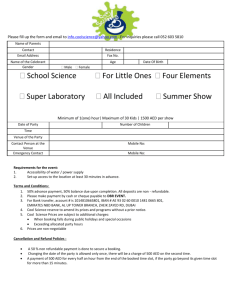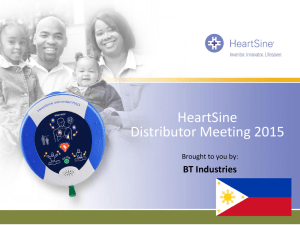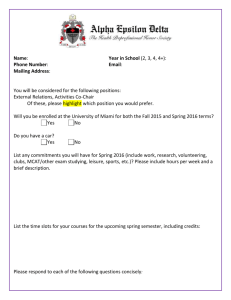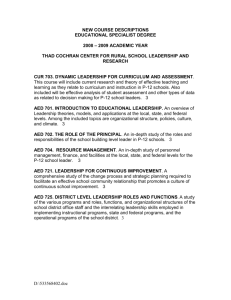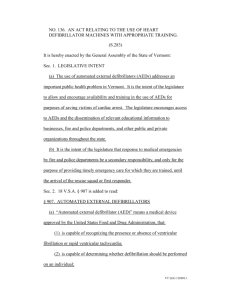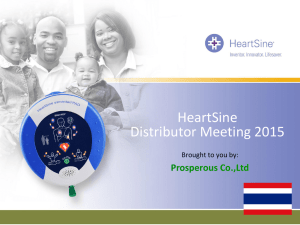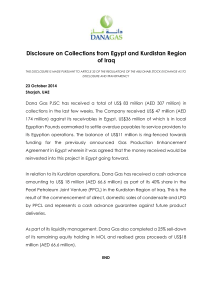AED Guidelines and Procedures - California State University, East Bay
advertisement
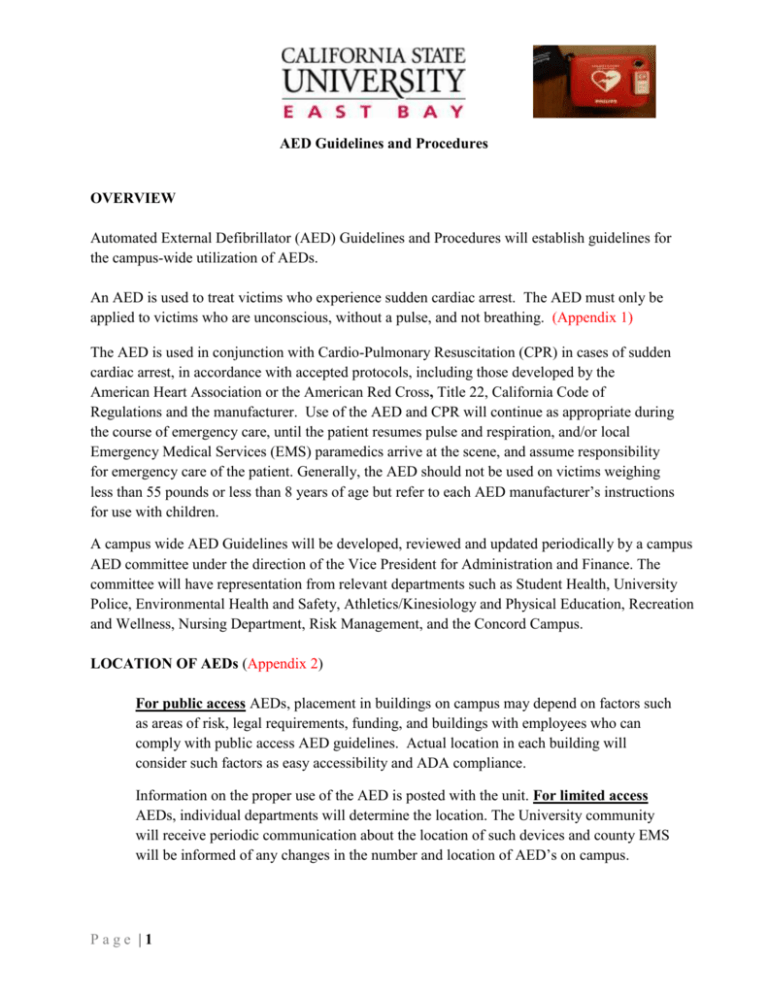
AED Guidelines and Procedures OVERVIEW Automated External Defibrillator (AED) Guidelines and Procedures will establish guidelines for the campus-wide utilization of AEDs. An AED is used to treat victims who experience sudden cardiac arrest. The AED must only be applied to victims who are unconscious, without a pulse, and not breathing. (Appendix 1) The AED is used in conjunction with Cardio-Pulmonary Resuscitation (CPR) in cases of sudden cardiac arrest, in accordance with accepted protocols, including those developed by the American Heart Association or the American Red Cross, Title 22, California Code of Regulations and the manufacturer. Use of the AED and CPR will continue as appropriate during the course of emergency care, until the patient resumes pulse and respiration, and/or local Emergency Medical Services (EMS) paramedics arrive at the scene, and assume responsibility for emergency care of the patient. Generally, the AED should not be used on victims weighing less than 55 pounds or less than 8 years of age but refer to each AED manufacturer’s instructions for use with children. A campus wide AED Guidelines will be developed, reviewed and updated periodically by a campus AED committee under the direction of the Vice President for Administration and Finance. The committee will have representation from relevant departments such as Student Health, University Police, Environmental Health and Safety, Athletics/Kinesiology and Physical Education, Recreation and Wellness, Nursing Department, Risk Management, and the Concord Campus. LOCATION OF AEDs (Appendix 2) For public access AEDs, placement in buildings on campus may depend on factors such as areas of risk, legal requirements, funding, and buildings with employees who can comply with public access AED guidelines. Actual location in each building will consider such factors as easy accessibility and ADA compliance. Information on the proper use of the AED is posted with the unit. For limited access AEDs, individual departments will determine the location. The University community will receive periodic communication about the location of such devices and county EMS will be informed of any changes in the number and location of AED’s on campus. Page |1 AED Guidelines and Procedures RESPONSIBILITIES AED Committee Responsibilities Develop, review and update the campus AED Guidelines periodically. Assure that the University is in compliance with all laws and regulations pertaining to the use and implementation of AEDs. Determine number, location and placement of AEDs. Evaluate implementation of AEDs for public access versus secured/limited access. May consider such factors as risk management, budget, security, accessibility and regulatory requirement in the decision. Coordinate vendor and AED selection, purchase, installation and ancillary features. Oversee all AEDs on campus and regularly notify/update the University community, and Alameda, and Contra Costa Counties EMS, of their location and accessibility. Develop policies and procedures and assign responsibility for equipment inspection and maintenance based on legal, manufacturer and other requirements. Develop policies and procedures and assign responsibility for training of staff on the use of AEDs. List of AED committee members. (Appendix 3) Medical Director Responsibilities The Medical Director of the AED Program is a physician, designated by the Student Health and Counseling Services (SHCS) Director. Providing medical direction for the use of the AED device. Writing a prescription for use of the AED device. Reviewing and approving guidelines and training requirements for emergency procedures related to the use of AEDs and CPR. Evaluating post-event reviews. Participating in the development of the campus emergency response plans. Updating Alameda and Contra Costa counties EMS, as per regulation requirements. Reviewing laws and regulations that govern the use of AEDs. Campus Program Coordinator Responsibilities Page |2 Organizing meetings periodically, at least annually, and as needed. Meetings May be called to discuss changes in law or regulatory requirements, an event or incident, or to make a change in policy, equipment, etc. AED Guidelines and Procedures Maintains Checklist of Notifications to Counties, University Community and Housing Residents. Working with the Medical Director and Department Coordinators to ensure that appropriate records are kept, such as monitoring Department AED Monthly Checklists, Department Coordinators Training Records, AED guidelines and protocols, etc. Annually receives from Department Coordinators Monthly Checklists and Training Records. Reviewing and revising the AED Policies and Procedures annually, or as needed, in conjunction with the AED committee and other relevant campus personnel. Working with Medical Director to monitor the effectiveness of the AED program. Working as a liaison between campus and AED manufacturer. Communicating with the Medical Director on issues related to this medical emergency response plan including post-event reviews. Discussing with the Medical Director any changes reported by the Department AED Coordinators. Informing/updating the campus community on location and use of AED annually. Department AED Coordinator Responsibilities Responsible for maintaining and inspecting equipment per manufacturer’s recommendations. (Appendix 4) Keeping all maintenance records for review by internal or external inspectors. Ordering necessary equipment, supplies, and accessories. Arranging, tracking and maintaining records for personnel training (Appendix 5). Annually provides copies of Department Coordinators Monthly Checklists and Training Records to Campus Program Coordinator. Notifying AED Program Coordinator of any changes in equipment and location. Attending and representing their area at AED Committee meetings. Developing and maintaining procedures for the use, maintenance, and training for the AED(s) in their area. Discretion to assigning the above responsibilities to others who are properly trained. EQUIPMENT CHECKLIST All AED equipment and accessories shall be maintained in a state of readiness and per manufacturer guidelines. At a minimum, the AED must be checked at least once every 30 days and after each use. Each department will develop policies and procedures on the equipment Page |3 AED Guidelines and Procedures maintenance specific to the model/type of defibrillator they have and based on the recommendations of the manufacturer. Records of equipment checks will be kept by each department coordinator and made available for inspection to the Campus AED coordinator upon request. It is recommended that records be kept for at least 2 years. Submit a copy of the Department Monthly Checklist annually to the Campus Program Coordinator. TRAINING AEDs should only be used by persons trained in CPR and AED use, such as programs sponsored by the American Heart Association or American Red Cross. Each Department’s AED Coordinator, in conjunction with their department personnel and regulations that govern their area, will determine who will be trained. For public access defibrillators, trained personnel should be present in the building, during normal operating hours. In situations where the building is rented out, and the building has a public access defibrillator, the rental contract/agreement should address the presence of the defibrillator, and having trained personnel in how to use it. Training records will be maintained by the department coordinator and made available for inspection to the Campus AED coordinator upon request. It is recommended that records be kept for at least 2 years. Submit a copy of the Department Training Records annually to the Campus Program Coordinator. NOTIFICATION Depending on the campus county, (Alameda or Contra Costa) EMS will be notified of the specific location of all AEDs on campus, and updated if there are any changes. Likewise, the campus community will be informed of the location of AEDs annually. It is recommended that Housing residents be informed of the campus location of AEDs and their use. POST EVENT REVIEW An AED Incident Report Form will be used to report an event (Appendix 6). Page |4 AED Guidelines and Procedures After each AED use the AED Committee will review the incident to assess the effectiveness of the AED program. As the result of an incident, the Committee may make recommendations to revise and improve the program including location, number, placement or type of AEDs and associated guidelines and procedures. The manufacturer of the AED will be contacted, to download the post event information for the AED Medical Director. OTHER RESOURCES State and Federal requirements Manufacturer’s Contact information How to use the Philips FRx AED Revised 2/19/13 Page |5
